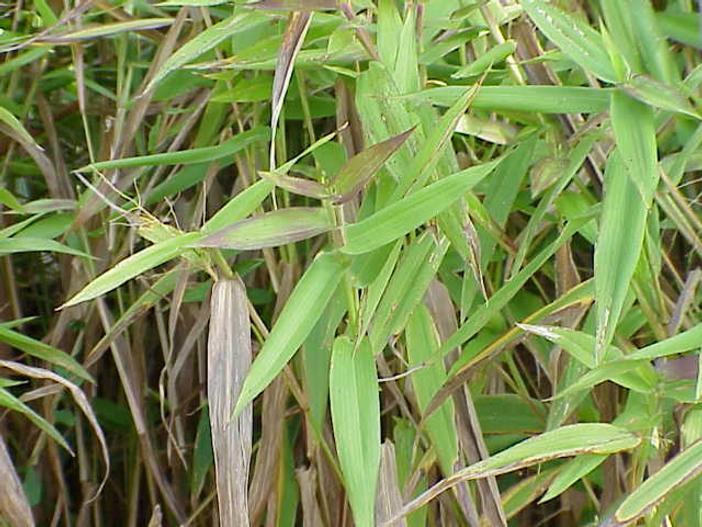Deertongue
(Panicum clandestinum)
Deertongue (Panicum clandestinum)
/
/

Kurt Stüber
CC BY-SA 3.0
Image By:
Kurt Stüber
Recorded By:
Copyright:
CC BY-SA 3.0
Copyright Notice:
Photo by: Kurt Stüber | License Type: CC BY-SA 3.0 | License URL: http://creativecommons.org/licenses/by-sa/3.0/ | Uploader: Topjabot | Publisher: Wikipedia Commons









Estimated Native Range
Summary
Panicum clandestinum, commonly known as Deertongue, is a deciduous perennial grass native to the understory of open woodlands and forest edges in the Eastern United States and Ontario. It typically grows to a height of 2-4 feet (0.6-1.2 meters) and a width of 1-3 feet (0.3-0.9 meters), featuring a clumping form with broad, lance-shaped leaves that resemble a deer’s tongue. The plant produces inconspicuous greenish flowers in late summer, which are not particularly showy, but they do contribute to the plant’s overall texture in the landscape.
Deertongue is valued for its ability to thrive in shaded conditions and its low maintenance requirements, making it a suitable choice for naturalized areas, woodland gardens, and as a ground cover. It is also used for erosion control due to its clumping habit. Deertongue prefers partial shade to full sun and can tolerate a range of soil types, from dry to moist, provided they have good drainage. While it is drought-tolerant once established, it benefits from occasional watering during prolonged dry spells. Gardeners should be aware that in some conditions, it can spread vigorously, potentially becoming invasive.CC BY-SA 4.0
Deertongue is valued for its ability to thrive in shaded conditions and its low maintenance requirements, making it a suitable choice for naturalized areas, woodland gardens, and as a ground cover. It is also used for erosion control due to its clumping habit. Deertongue prefers partial shade to full sun and can tolerate a range of soil types, from dry to moist, provided they have good drainage. While it is drought-tolerant once established, it benefits from occasional watering during prolonged dry spells. Gardeners should be aware that in some conditions, it can spread vigorously, potentially becoming invasive.CC BY-SA 4.0
Plant Description
- Plant Type: Grass
- Height: 2-4 feet
- Width: 1-3 feet
- Growth Rate: Moderate
- Flower Color: N/A
- Flowering Season: Summer
- Leaf Retention: Evergreen
Growth Requirements
- Sun: Full Sun, Part Shade
- Water: Low
- Drainage: Slow, Medium, Fast
Common Uses
Bird Garden, Butterfly Garden, Deer Resistant, Drought Tolerant, Erosion Control, Fire Resistant, Low Maintenance, Rabbit Resistant, Water Garden
Natural Habitat
Native to the understory of open woodlands and forest edges
Other Names
Common Names: Deer-Tongue Witchgrass, Witch Grass
Scientific Names: , Panicum clandestinum, Dichanthelium clandestinum, Panicum decoloratum, Panicum latifolium var. clandestinum, Chasea clandestina, Milium clandestinum, Panicum clandestinum var. pedunculatum, Panicum pedunculatum,
GBIF Accepted Name: Panicum clandestinum L.